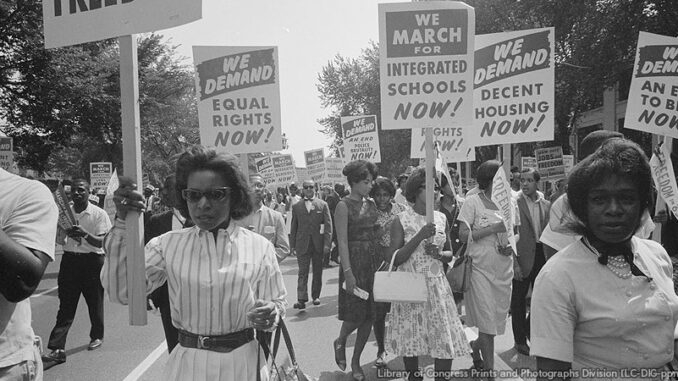
The modern civil rights movement in the United States is typically said to have occurred between 1955 and 1968. The start of mass public protests in the South began in December 1955 with the Montgomery bus boycott and culminated with the passage of the federal Civil Rights Act in 1968. During these years, many people and events helped define this era of confrontation and change. The goals of social equality that were fought for during this period are still incomplete. Still, the inspiration of the men and women who spoke, sang, marched, and acted for those goals remain with the United States today.
One of the civil rights movements’ biggest moments was the 1963 March on Washington for Jobs and Freedom. (More commonly known today simply as the March on Washington.) August 28, 2013 marks the 50th anniversary of that historic day, which included Martin Luther King, Jr.’s famous “I Have a Dream” speech. To celebrate the impact of this event, commemorative events are occurring all over the country. Washington D.C. will celebrate by holding a week-long series of events.
The March

The March on Washington for Jobs and Freedom brought thousands of protest to the the nation’s capitol in August 1963.
The idea for a national march on the nation’s capitol to protest civil rights started back in the 1940s. An activist named A. Phillip Randolph had planned several large gatherings of African American workers to protest discrimination in hiring by the U.S. military during World War II. It, and similar rallies, were ultimately canceled. The timing seemed better in 1963. For one, the civil rights movement had gained momentum since the mid 1950s. It was also the 100th anniversary of the signing of the Emancipation Proclamation, the executive order signed by president Abraham Lincoln that ended slavery in the United States. Additionally, a march in 1963 would line up with proposed civil rights legislation begin considered by President John F. Kennedy and the Congress. Randolph and the other organizers believed that a public protest would put pressure on the federal government to act.
The organizers of the March on Washington for Jobs and Freedom put a lot of work into making sure things ran smoothly. They considered everything from ensuring that there was enough parking, enough bathrooms, and enough water for the expected crowds. (It was very hot that day.) They also had to make 10,000 signs for marchers to carry and find ways to distribute manuals to participants that addressed questions such as “Why We March.”
Despite this careful planning, high-level government officials, including President Kennedy, were very concerned that rioting could occur. Many federal employees chose not to go to work that day. Hospitals canceled all no-emergency surgeries in order to be prepared for mass casualties. But organizers A. Philip Randolph, James Farmer, Bayard Rustin, John Lewis, Roy Wilkins, Whitney Young, and Martin Luther King, Jr. all worked with the Kennedy administration to ensure that the event would proceed in the spirit of King’s nonviolent protests.
A record crowd showed up, estimated between 200,000 and 300,000–the largest public demonstration in the country of its kind to date. It was peaceful, overall. Protestors marched as a group from the Washington Monument to the Lincoln Memorial, where there was a program that featured speeches and musical numbers from guests such as: Rosa Parks, Mahalia Jackson, Bob Dylan, Joan Baez, several leaders of civil rights organizations, and Dr. Martin Luther King, Jr.
The Speech
Many students know quite a bit about civil rights activist, Martin Luther King, Jr. His life and work is regularly parts of educational curriculum. He is also often the subject of many student reports and projects. He spoke and wrote throughout his career as both a preacher and activist. Before August 28, 1963, Dr. King had long thought about who his audience might be on that day.
In addition to dissatisfied African-Americans, Dr. King sought to speak to others who disagreed with the nation’s segregation policies, but had not done anything to improve the situation. His stirring words of hope and optimism changed the lives of those looking for guidance and leadership. In crafting the speech, which was actually titled, “Normalcy, Never Again” Dr. King referenced the Gettysburg Address, the Bible, and William Shakespeare’s Richard III.
The famous phrase the speech is known for was, perhaps, an improvisation the day of the Mach. Toward the end of his address, singer Mahalia Jackson, who had heard about a speech King had given in Detroit earlier that summer, called out for him to mention “the dream.” King drew upon his years of public speaking experience and many of this previous protest moments to deliver one of the most famous events in United States history, reaching out to the witnesses in Washington D.C. as well as to people across the nation and the world who say it on television. The seventeen-minute speech is now considered one of the the greatest and most influential speeches of the twentieth century.
Related Links:
- The King Center, located in Atlanta, works to carry on the work for equality and social protest articulated by Dr. Martin Luther King, Jr. Visit the center’s Web site to learn more about Dr. King, search a digital archive of King materials, and learn how Dr. King’s dream still inspires people today.
- The Center for the Study of Civil and Human Rights Laws is helping to organize a 50th anniversary event on Wednesday, August 28, 2013. Visit its Web site for more information.
